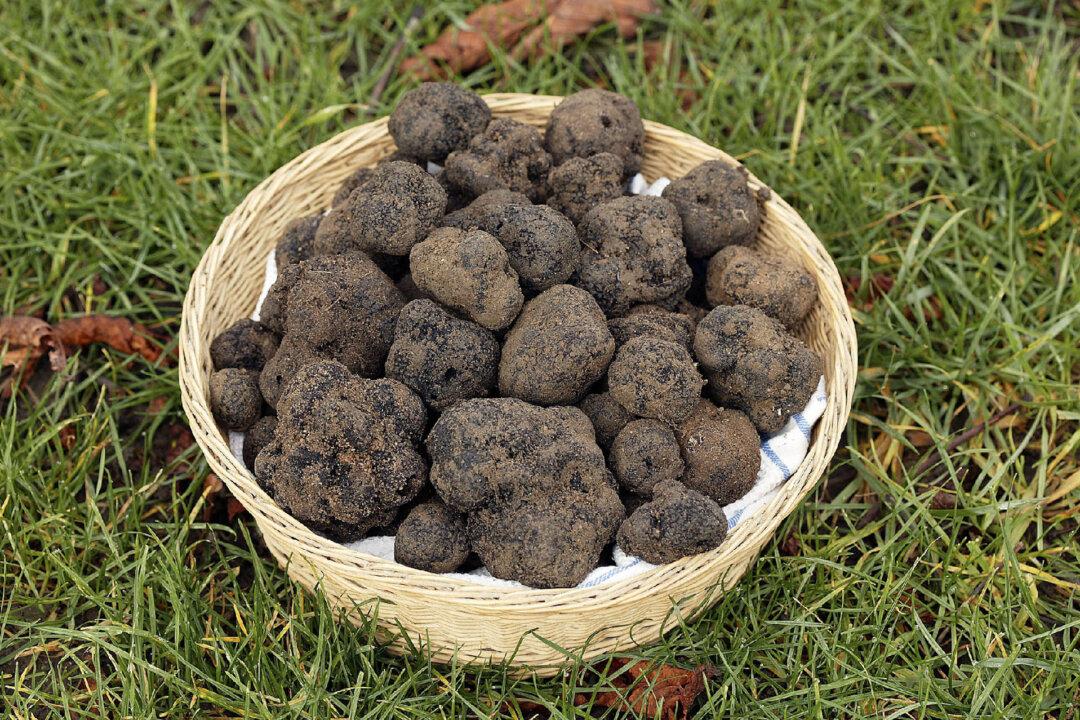Nadine was excited. She scampered along a haphazard route, pausing now and then to sniff at the ground. Occasionally she began to dig in the dirt, her breath quickening and eyes widening. But she was not permitted to complete the excavation she had begun. That task was finished by Vanessa, who distracted Nadine with a tasty treat and used a trowel to discover—and uncover—the object of their search.
Nadine is a dog, but she’s no ordinary canine. She is trained to find truffles, and I recently accompanied her and her handler, Vanessa Shea, on a hunt for those elusive, rather unattractive fungi that more than make up in value what they might lack in appearance.

Our quest took place at Virginia Truffles, a family-owned enterprise in that state, but truffles are grown in orchards that span the country from Maryland, Kentucky and Tennessee to Idaho, Oregon and California. The North American Truffle Growers Association estimates the number to be as high as 400.
My experience began with an introduction to everything truffle delivered around a blazing fire pit by Vanessa, her sister Olivia and their mother, Patrice. My fellow adventurers and I benefited from our hosts’ encyclopedic knowledge, which included historic facts, truffle tidbits and recipes for using these highly prized gastronomic gems in a variety of ways.
Who knew, for example, that truffles were prized at the time of the Egyptian, Greek and Roman empires; that the medieval Catholic Church largely banned consumption of “the devil’s fruit”; and that they were a favorite food of French Queen Catherine de Medici and King Louis XIV?
Modern truffling is said to have evolved when French farmers observed pigs uprooting a favorite food, and then trained them for the hunt. Because pigs love truffles, however, they often consumed their prize before the farmer could rescue it. Trackers began training dogs, who happily work for canine treats.
The object of the hunt is an edible fungus that grows several inches underground beneath tree branches. Favorite hosts are oak and hazelnut trees. Truffle farmers can wait for as long as 10 years after planting their seedlings before they get their first harvest. Then the crop is retrieved during a truncated harvesting time of only a few months. It turns out that raising the subterranean fungus is as much an art as a science and also qualifies as a labor of love.
Love between human and dog was evident as I followed Nadine and Vanessa, walking rapidly through the orchard with Vanessa repeating the mantra “Where’s the truffle?” Our trek, which lasted a little over an hour, produced five.
A post-hunt mini buffet included carrot soup, deviled eggs, pastrami and brie cheese, all enhanced with fresh truffle shavings or slices. While the earthy, pungent odor of the tubers that Nadine unearthed was almost too strong for my sense of smell and taste buds, the hints of truffle in the food added a unique dimension that I found easy to enjoy but difficult to describe.

During a post-snack visit to the small onsite laboratory, Patrice explained the truffle-cleaning process, which includes cutting out any small rotted areas. She also described the truffle-grading guidelines that have been adopted by the United Nations and mentioned that some of the tubers, which the farm sells to nearby white-tablecloth restaurants, are priced at more than $120 an ounce.
She also listed some of the many ways truffles can be used to add flavor to a variety of foods, several of which had been demonstrated and enjoyed during our snack. While some cuisine seems like a natural fit—eggs, soup, mashed potatoes, infusing sauces and dips, making truffle butter and cream—the possibilities for using truffles to titillate taste buds are virtually endless.
Having been hooked by the distinctive scent, lore and taste of this nondescript but delicious taste-enhancer, I purchased truffle-infused honey, salt and pepper to bring home. I look forward to enjoying them along with memories of a unique experience that will linger on my tongue—and in my mind.
When You Go
More information about truffles and a list of growers throughout the United States are available at www.trufflegrowers.com, the website of the North American Truffle Growers Association.







